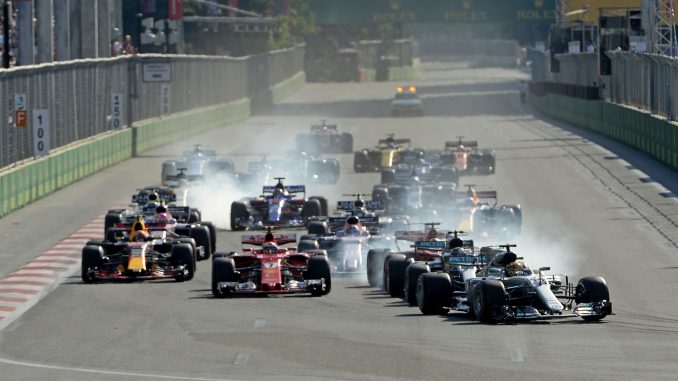
The 2019 F1 season once again contains 21 races and runs from March and for the first time finishes in December. Here’s our guide to the who, what and where for this year, which we’ll update as more information comes out from the teams and F1.
This season features the same 10 teams as last year, with the team formerly known as Force India starting their 1st full season under their new Racing Point name, along with Sauber’s rebranding to Alfa Romeo Racing and 3 drivers are set to make their F1 racing debuts in 2019 (Lando Norris, George Russell & Alexander Albon) with 3 other drivers returning to the grid after various amounts of time away (Robert Kubica, Antonio Giovinazzi & Daniil Kvyat) and with Charles Leclerc, Carlos Sainz, Daniel Ricciardo, Kimi Raikkonen, Lance Stroll & Pierre Gasly moving teams that means that only Mercedes & Haas will retain the same lineups as 2018.
Mercedes-AMG Petronas Motorsport – Car W10 EQ Power+ – Engine: Mercedes – Launch date: February 13th
- 44 Lewis Hamilton
- 77 Vatteri Bottas
Scuderia Ferrari Mission Winnow – Car SF90 – Engine: Ferrari – Launch date: February 15th
- 5 Sebasitan Vettel
- 16 Charles Leclerc
Rich Energy Haas F1 Team – Car VF-19 – Engine: Ferrari – Launch date: February 7th
- 8 Romain Grosjean
- 20 Kevin Magnussen
McLaren F1 Team – Car: MCL34 – Engine: Renault – Launch date: February 14th
- 2 Lando Norris (R)
- 55 Carlos Sainz
Sport Pesa Racing Point- Car: RP19 – Engine: Mercedes – Launch date: February 13th
- 11 Sergio Perez
- 18 Lance Stroll
Aston Martin RedBull Racing – Car: RB15 – Engine: Honda – Launch date: February 13th
- 10 Pierre Gasly (Australia to Hungary)
- 23 Alex Albon (R) (Belgium to Abu Dhabi)
- 33 Max Verstappen
Renault F1 Team – Car: RS19- Engine: Renault – Launch date: February 12th
- 3 Daniel Ricciardo
- 27 Nico Hulkenberg
Alfa Romeo Racing (formerly Sauber) – Car: TBA – Engine: Ferrari – Launch date: February 18th
- 7 Kimi Raikkonen
- 99 Antonio Giovinazzi
RedBull Toro Rosso Honda – Car: STR14 – Engine: Honda – Launch date: February 11th
- 23 Alexander Albon (R) (Australia to Hungary)
- 10 Pierre Gasly (Belgium to Abu Dhabi)
- 26 Daniil Kvyat
Williams Racing – Car: FW42 – Engine: Mercedes – Launch date: February 11th
- 63 George Russell (R)
- 88 Robert Kubica
Testing is once again limited during the season with the 2 days of testing after the Bahrain Grand Prix and 2 days at the Hungaroring before the Summer break in August. Pirelli will be running private tyre tests during the season and we expect the usual young drivers test to take place in early December after the last race in Abu Dhabi
Pre Season:
- Barcelona Feb 18-21 (Afternoon sessions from 1PM GMT live on Sky Sports F1)
- Barcelona Feb 26 – March 1
In Season
- Bahrain March 2-3
Tyre Tests:
- TBC
Young Drivers Test
- Abu Dhabi Dec 3-4 (TBC)
For the 2nd year in a row we’ve got 21 races to look forward to this season. But unlike 2018 there isn’t another triple-header as FOM have now said that the 3 week back to back to back run was a “one-off” so as not to clash with the Football World Cup. There are 5 sets of back to back races this year France/Austria, Germany/Hungary, Belgium/Italy, Singapore/Russia & Mexico/USA and the summer break will be for most of August between Hungary and Belgium. The 1000th Grand Prix is scheduled for this season at the 3rd race of the year in China.
| Round | Race | Circuit | FP1 & FP2 | FP3 & Qualifying | Race |
| 1 | Australian Grand Prix | Melbourne Grand Prix Circuit, Melbourne | 15 March 2019 | 16 March 2019 | 17 March 2019 |
| 2 | Bahrain Grand Prix | Bahrain International Circuit, Sakhir | 29 March 2019 | 30 March 2019 | 31 March 2019 |
| 3 | Chinese Grand Prix | Shanghai International Circuit, Shanghai | 12 April 2019 | 13 April 2019 | 14 April 2019 |
| 4 | Azerbaijan Grand Prix | Baku City Circuit, Baku | 26 April 2019 | 27 April 2019 | 28 April 2019 |
| 5 | Spanish Grand Prix | Circuit de Barcelona-Catalunya, Montmeló | 10 May 2019 | 11 May 2019 | 12 May 2019 |
| 6 | Monaco Grand Prix | Circuit de Monaco, Monte Carlo | Thursday 23 May 2019 | 25 May 2019 | 26 May 2019 |
| 7 | Canadian Grand Prix | Circuit Gilles Villeneuve, Montreal | 07 June 2019 | 08 June 2019 | 09 June 2019 |
| 8 | French Grand Prix | Circuit Paul Ricard, Le Castellet | 21 June 2019 | 22 June 2019 | 23 June 2019 |
| 9 | Austrian Grand Prix | Red Bull Ring, Spielberg | 28 June 2019 | 29 June 2019 | 30 June 2019 |
| 10 | British Grand Prix | Silverstone Circuit, Silverstone | 12 July 2019 | 13 July 2019 | 14 July 2019 |
| 11 | German Grand Prix | Hockenheimring, Hockenheim | 26 July 2019 | 27 July 2019 | 28 July 2019 |
| 12 | Hungarian Grand Prix | Hungaroring, Mogyoród | 02 August 2019 | 03 August 2019 | 04 August 2019 |
| 13 | Belgian Grand Prix | Circuit de Spa-Francorchamps, Stavelot | 30 August 2019 | 31 August 2019 | 01 September 2019 |
| 14 | Italian Grand Prix | Autodromo Nazionale Monza, Monza | 06 September 2019 | 07 September 2019 | 08 September 2019 |
| 15 | Singapore Grand Prix | Marina Bay Street Circuit, Singapore | 20 September 2019 | 21 September 2019 | 22 September 2019 |
| 16 | Russian Grand Prix | Sochi Autodrom, Sochi | 27 September 2019 | 28 September 2019 | 29 September 2019 |
| 17 | Japanese Grand Prix | Suzuka International Racing Course, Suzuka | 11 October 2019 | 12 October 2019 | 13 October 2019 |
| 18 | Mexican Grand Prix | Autódromo Hermanos Rodríguez, Mexico City | 25 October 2019 | 26 October 2019 | 27 October 2019 |
| 19 | United States Grand Prix | Circuit of the Americas, Austin, Texas | 01 November 2019 | 02 November 2019 | 03 November 2019 |
| 20 | Brazilian Grand Prix | Autódromo José Carlos Pace, São Paulo | 15 November 2019 | 16 November 2019 | 17 November 2019 |
| 21 | Abu Dhabi Grand Prix | Yas Marina Circuit, Abu Dhabi | 29 November 2019 | 30 November 2019 | 01 December 2019 |
There are a few rule changes for 2019, the most visible ones will be the new aerodynamic regulations around the simplified front wings with and the DRS slot on the rear wing being widened to make DRS more powerful. Also the maximum fuel limit is raised from 105kg to 110kg in an attempt to reduce the fuel saving tactics that have come into play since mid-race refuelling was stopped in 2010
Another noticeable change will be the tyres; instead of the 5 dry compound colours, we will just see 3 all season. While Pirelli have created a variety of compounds with differing hardness and durability, we’ll only see white for the hardest tyre of the weekend, yellow for the medium and red for the softest available.
From this season, the driver’s weight will not be taken into account when weighing the car and instead drivers will have to weigh a minimum of 80kg (176.4lbs) otherwise ballast will be added to the seat area of the car to make up the weight.

Leave a Reply
You must be logged in to post a comment.